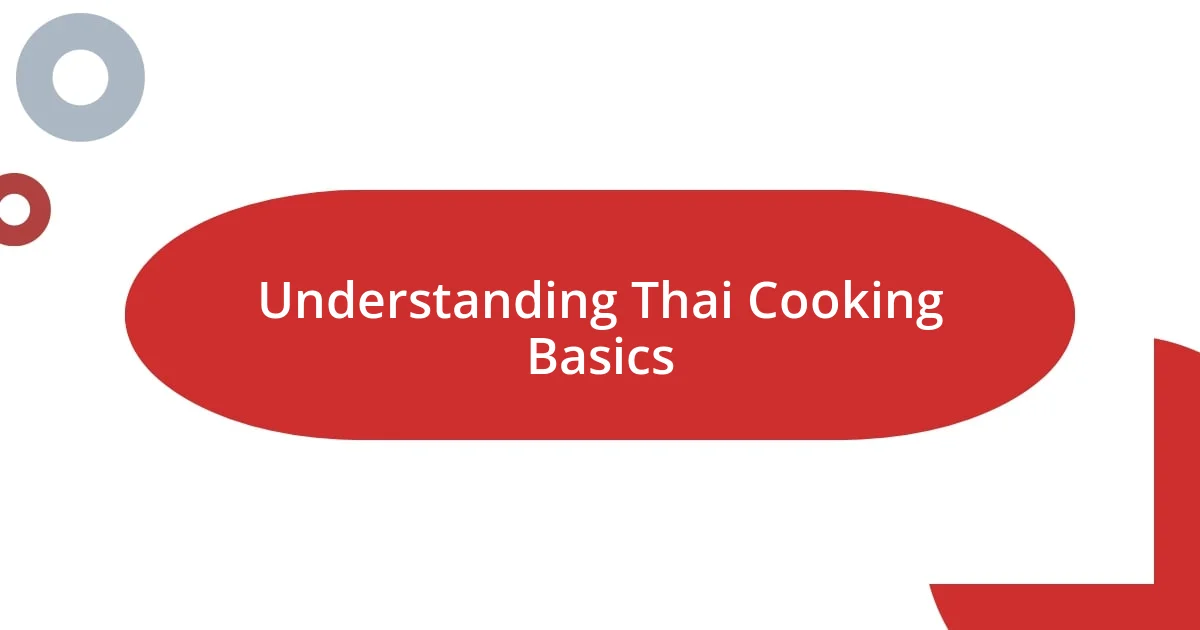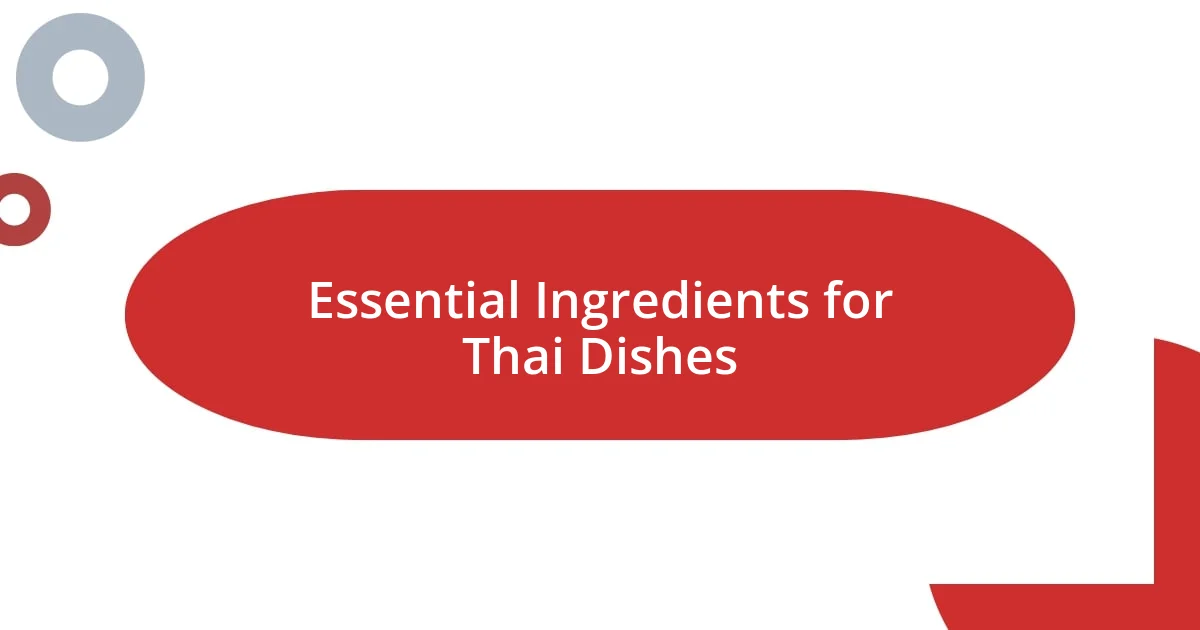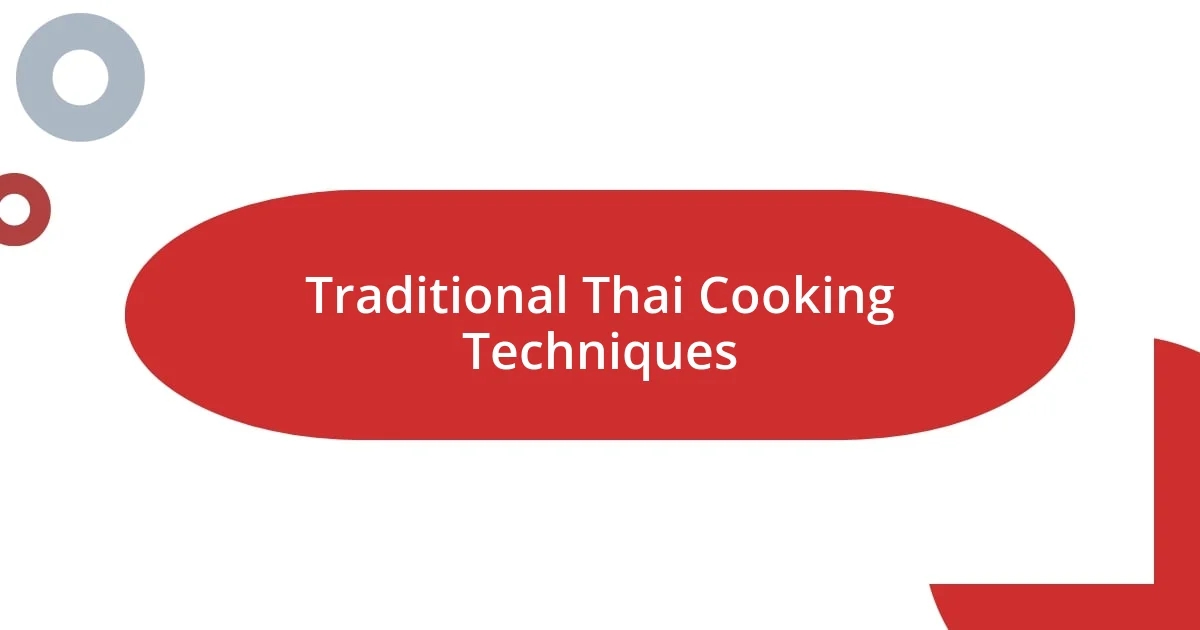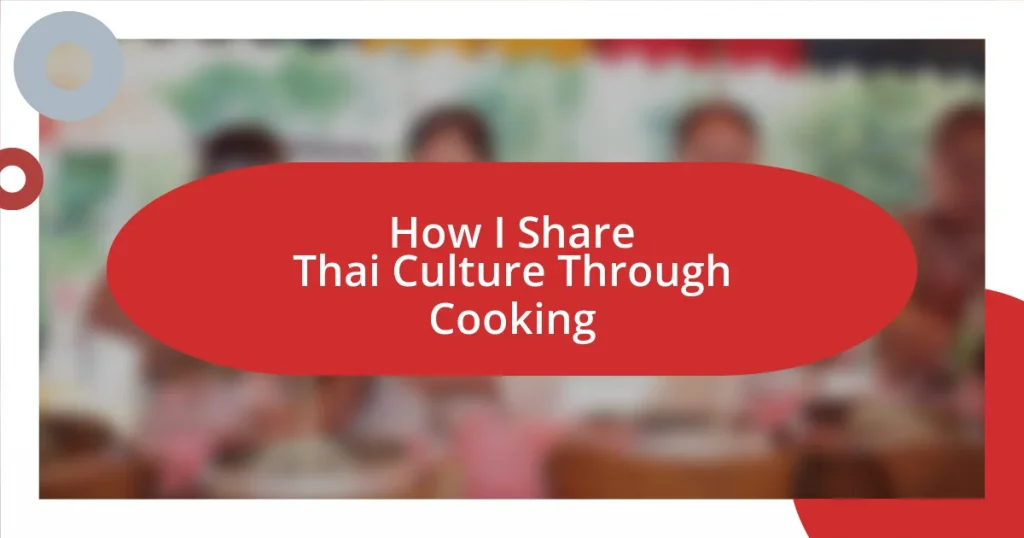Key takeaways:
- The balance of flavors—sweet, sour, salty, spicy, and bitter—is essential in crafting authentic Thai dishes, enhancing the overall culinary experience.
- Fresh herbs and ingredients, such as fish sauce, chilies, and lemongrass, are crucial to creating vibrant and aromatic Thai flavors that foster memorable dining experiences.
- Engaging others in cooking not only promotes cultural exchange but also fosters creativity and connection, turning meals into shared experiences filled with joy and laughter.

Understanding Thai Cooking Basics
When I first stepped into a Thai kitchen, I was struck by the vibrant colors and bold aromas—it was an awakening of the senses. One fundamental aspect of Thai cooking is the balance of flavors: sweet, sour, salty, spicy, and bitter. Have you ever tasted a dish that just resonates with your palate? This harmony is fundamental in crafting authentic Thai dishes and truly elevates the entire culinary experience.
As I experimented with different ingredients, I quickly learned that fresh herbs and spices are crucial in Thai cooking. For example, lemongrass adds a citrusy zing, while galangal provides earthiness. I remember the first time I made a green curry; the fresh basil and kaffir lime leaves made my kitchen smell like a Thai market. Isn’t it fascinating how scents can transport you to another place?
One essential cooking technique in Thai cuisine is stir-frying, a method that captures flavors and maintains the crispness of vegetables. I remember the thrill of hearing that satisfying sizzle when my ingredients hit the hot wok. Isn’t that sound the signature of great cooking? By mastering these techniques, you not only make delicious food but also share a piece of Thai culture that brings people together.

Essential Ingredients for Thai Dishes
Thai cuisine thrives on its fresh and aromatic ingredients that create that distinctive balance. Take fish sauce, for example. When I first used it in my cooking, I was amazed by how just a few drops could transform a dish from mundane to extraordinary. It adds that essential umami flavor, anchoring the meal with depth. Have you ever noticed how certain ingredients can completely change your cooking experience?
Herbs like cilantro and Thai basil are absolute staples in my kitchen. The first time I used them, it was like a burst of flavor that brought my dishes to life. The moment you chop fresh cilantro, its aroma fills the space, instantly uplifting the atmosphere and hinting at the culinary adventure ahead. It’s incredible how these humble herbs can turn a simple meal into something exciting and vibrant!
Moreover, the presence of chilis in Thai cooking is non-negotiable. They add that perfect hot kick, balancing out sweetness and sourness. I can still recall the first time I went too heavy on the chilies in a pad thai; my friends’ reactions were priceless! But through those fiery experiences, I learned to respect the heat and its ability to bring people together around the table, sharing a laugh amid the bold flavors.
| Ingredient | Flavor Profile |
|---|---|
| Fish Sauce | Salty and Umami |
| Lemongrass | Citrusy and Fresh |
| Thai Basil | Sweet and Spicy |
| Chilis | Spicy and Hot |

Traditional Thai Cooking Techniques
Thai cooking is steeped in rich traditions that manifest through various techniques. One of my favorites is the process of slow-cooking. I remember the first time I prepared a massaman curry; the ingredients simmered gently for hours, allowing the spices to infuse fully. That anticipation of the dish gradually coming together is a thrill I still relish—it’s like a meditation in the kitchen. Other techniques like steaming and grilling also play crucial roles, offering different textures and flavors that define Thai dishes.
- Stir-frying: Quick and high-heat cooking in a wok, preserving the crispness of vegetables.
- Slow-cooking: Enhances deep flavors, often used in curries and stews.
- Steaming: A healthy method that retains nutrients and natural flavors, often used for dumplings and fish.
- Grilling: Adds a smoky char, commonly seen in satays and marinated meats.
- Pounding: Used to create pastes and incorporate ingredients fully, recalling the times when I joyfully pounded garlic and chilies in a mortar and pestle; what a workout!
Each technique not only shapes the dish but also reflects a slice of Thai culture, creating an engaging culinary journey that brings joy and warmth to the table.

Popular Thai Recipes to Try
One recipe that always warms my heart is Tom Yum soup. The first time I made it, I was struck by the way the aromatic herbs melded with the tartness of lime. It’s one of those dishes that fills your home with a fragrance so inviting that it draws loved ones into the kitchen. I still remember how my friends gathered around the dining table, eagerly slurping the spicy broth and sharing stories, each sip igniting laughter and familiarity. Have you ever noticed how food can create cherished memories?
Another standout is Pad Thai. I love making this dish because it effortlessly balances sweet, savory, and sour flavors. The first time I crafted the perfect sauce, I felt like an artist creating a masterpiece. Watching the rice noodles dance in the pan as they absorbed the flavors was a delight. Plus, adding crushed peanuts at the end offers that wonderful crunch. It’s such a crowd-pleaser, which makes it a joy to serve at gatherings. What’s your favorite comfort food that brings people together?
And let’s not overlook Green Curry. When I first tasted it, I was mesmerized by the vibrant color and how just a spoonful packed a flavorful punch. The creamy coconut milk balanced perfectly with the spicy green curry paste, and it reminded me of sunny days in Thailand. Now, whenever I make it, I aim for that same burst of nostalgia, hoping to transport my friends on a short culinary trip. Have you ever tasted something that instantly reminded you of a beautiful memory?

Hosting a Thai Dinner Party
When I think about hosting a Thai dinner party, the first thing that comes to mind is the vibrant atmosphere it creates. One of my favorite moments is setting the table adorned with colorful cloths and hand-crafted dishes that reflect the essence of Thailand. There’s something magical about lighting incense or candles before the guests arrive—it’s like inviting them into a different world filled with aromas and warmth. Have you ever noticed how the ambiance can transform a meal into an experience?
As guests gather, I love sharing stories about each dish, intertwining them with memories from my own culinary journey. For instance, I often tell them about the first time I tried making Som Tum (spicy green papaya salad) at a street stall in Thailand. The vendor’s expert hands moved like poetry, and I became fascinated by how such simple ingredients could create a complex flavor profile. When I replicate this dish for my friends, we all chuckle at how far I’ve come since that day, and it often leads to laughter-filled discussions about our own cooking mishaps. Can you remember a time when food sparked joyful conversations among your friends?
When it comes to dessert, I never skip the Mango Sticky Rice. I remember the first time I made it, I was anxiously waiting for the perfect ripeness of the mangoes. The creamy coconut milk drizzled over the sticky rice felt like a hug in a bowl! Serving it at my dinner parties always elicits smiles and compliments, but the best part is watching everyone savor the sweetness together. There’s a unique joy in sharing the little bits of my culture through food, don’t you agree?

Engaging Others Through Cooking Events
When I host cooking events, I make it a point to engage everyone in the preparation process. I remember one event where we all gathered in the kitchen to make homemade spring rolls. The laughter as we clumsily wrapped our rolls, debating the perfect amount of filling, filled the air. It’s fascinating to see how people who may not usually cook come alive in that moment, eager to learn and share. Have you ever seen someone transform in the kitchen when they get a taste of creating something delicious?
I also love incorporating Thai cultural elements into these gatherings. For instance, I once introduced a mini lesson on the significance of certain herbs used in our dishes. Explaining how lemongrass is believed to bring good luck sparked a lively discussion about food traditions from various cultures. This exchange created a sense of community, as we bonded over stories and similarities, transcending the boundaries of our individual backgrounds. Have you found that sharing the stories behind your food can deepen connections?
To make these events even more special, I encourage everyone to try their hand at plating. I remember one evening when a friend crafted the most vibrant plate of Pad Kaprao. The pride in their eyes as they presented their dish was truly heartwarming. It’s amazing how food can empower and bring out creativity in people. Isn’t it incredible how a simple meal can become a canvas for personal expression?















